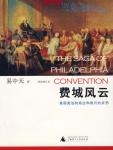Chapter 1 introduction
On September 17, 1787, after one last minor revision, delegates to the Philadelphia Convention decided to sign their signatures on the draft of the Constitution of the United States of America (the Federal Constitution) they had completed two days earlier, And submit this constitution to the Congress of the Confederation and the Congresses of the States for approval.As the last few delegates signed, the venerable 81-year-old Pennsylvania representative, Dr. Benjamin Franklin, gazed deeply over the chairman's chair at a piece of art on the opposite wall.It was an oil painting.On that oil painting, a round of red sun is gushing out. ①
Franklin told the representatives around him that sunrise is not easy to paint.Oil painters have found it difficult to distinguish the rising sun from the setting sun in their paintings.During this time, I have been watching the painting behind the chairman.My heart is full of hope and worry, and I can't tell whether the sun is rising in the east or setting in the west.Now I have the good fortune to know that it is rising, not falling.
Franklin's words full of revolutionary romanticism are touching, but things are not so optimistic.As an active participant in the Constitutional Convention, Dr. Franklin should have known it was not going well.First, some people were late, and then some people left early, and Rhode Island refused to send representatives to participate.Moreover, although Franklin himself made the last persuasion before signing, and his speech was full of wisdom and emotion, righteousness and sincerity, which were deeply touching, three representatives still refused to sign.They were: Virginia Representative Edmund Randolph, George Mason, and Massachusetts Representative Albridge Gurley.The prestige and status of these three people are very important.Elbridge Gerry was one of the pioneers of the American Revolution, having signed the Declaration of Independence and the Articles of Confederation.George Mason was one of the framers of the Virginia Constitution and drafted the "Bill of Rights", later known as the "Father of the Bill of Rights" in the United States.Edmund Randolph was one of the founders of the Constitutional Convention.It was he, as the first official speaker of the conference, who stated to the delegates the reasons and significance of holding this conference, and proposed the constitutional program drafted by his delegation (the "Virginia Program", also known as "Virginia Program"). Randolph Plan"), thus unveiling the theme of the conference.Such three people refused to sign in the end. The fate and future of the Constitution are really worrying.
In fact, after the Constitutional Convention, all three of them successively announced the reasons for their refusal to sign, which triggered a massive movement to boycott the Constitution.Edmund Randolph stated the reasons for the refusal to the Virginia Assembly and insisted on calling a second constitutional convention.George Mason, as the leader of the opposition, started a verbal war with James Madison, later known as the "father of the American Constitution", which prevented the Constitution from being ratified in Virginia.Elbridge Gerry also led the opposition to the ratification of the Federal Constitution when he returned to Massachusetts.Randolph, Mason and Gerry were not alone.Behind them, there are huge interest groups, many supporters, and beliefs that represent the universal principles of human beings.In short, the reasons for and against the draft constitution are extremely complex.It is precisely these complicated reasons that not only made the constitutional meeting last for three or four months, but also the whole process was full of twists and turns, full of dangers, and the nearly formed plan was almost aborted several times.It was only because both parties in the debate showed a calm and rational attitude, and the mediating party was able to put forward reasonable suggestions, that the Constituent Assembly overcame difficulties again and again and finally reached an agreement.But even so, the constitution, which was enacted after a lot of hard work, did not come into force until March 4, 1789, a year and a half later, and the sun in Franklin's heart finally jumped out of the horizon.It was a really hard leap.
The dystocia of the U.S. Constitution, of course, was not due to someone "interfering with it."In fact, those who advocated the adoption of the Constitution (they were called "Federalists") and those who opposed it (they were called "Anti-Federalists") were the founders of the United States and the Federal Constitution.Their thoughts are integrated into the founding spirit and legislative spirit of the United States.Moreover, it is precisely because of the absorption of both positive and negative opinions that the US Constitution has become a constitution that best embodies the spirit of constitutionalism and republic.It's just that in this way, the process of sunrise over the Atlantic Ocean is doomed to be tortuous and bumpy, with both dawn and dark clouds.
Then let us enjoy this magnificent picture from a distance!

